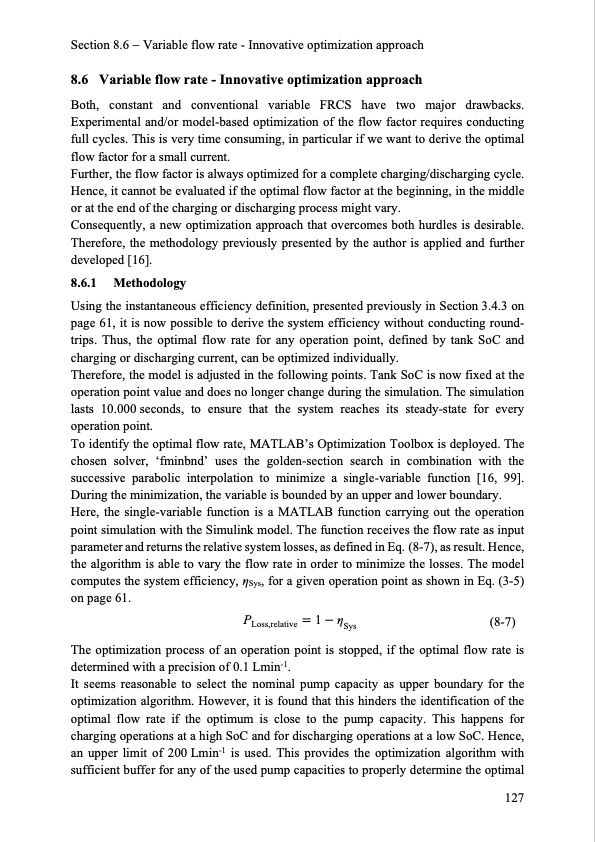
PDF Publication Title:
Text from PDF Page: 135
Section 8.6 Variable flow rate - Innovative optimization approach 8.6 Variable flow rate - Innovative optimization approach Both, constant and conventional variable FRCS have two major drawbacks. Experimental and/or model-based optimization of the flow factor requires conducting full cycles. This is very time consuming, in particular if we want to derive the optimal flow factor for a small current. Further, the flow factor is always optimized for a complete charging/discharging cycle. Hence, it cannot be evaluated if the optimal flow factor at the beginning, in the middle or at the end of the charging or discharging process might vary. Consequently, a new optimization approach that overcomes both hurdles is desirable. Therefore, the methodology previously presented by the author is applied and further developed [16]. 8.6.1 Methodology Using the instantaneous efficiency definition, presented previously in Section 3.4.3 on page 61, it is now possible to derive the system efficiency without conducting round- trips. Thus, the optimal flow rate for any operation point, defined by tank SoC and charging or discharging current, can be optimized individually. Therefore, the model is adjusted in the following points. Tank SoC is now fixed at the operation point value and does no longer change during the simulation. The simulation lasts 10.000 seconds, to ensure that the system reaches its steady-state for every operation point. To identify the optimal flow rate, MATLAB’s Optimization Toolbox is deployed. The chosen solver, ‘fminbnd’ uses the golden-section search in combination with the successive parabolic interpolation to minimize a single-variable function [16, 99]. During the minimization, the variable is bounded by an upper and lower boundary. Here, the single-variable function is a MATLAB function carrying out the operation point simulation with the Simulink model. The function receives the flow rate as input parameter and returns the relative system losses, as defined in Eq. (8-7), as result. Hence, the algorithm is able to vary the flow rate in order to minimize the losses. The model computes the system efficiency, ηSys, for a given operation point as shown in Eq. (3-5) on page 61. PLoss,relative 1 ηSys (8-7) The optimization process of an operation point is stopped, if the optimal flow rate is determined with a precision of 0.1 Lmin-1. It seems reasonable to select the nominal pump capacity as upper boundary for the optimization algorithm. However, it is found that this hinders the identification of the optimal flow rate if the optimum is close to the pump capacity. This happens for charging operations at a high SoC and for discharging operations at a low SoC. Hence, an upper limit of 200 Lmin-1 is used. This provides the optimization algorithm with sufficient buffer for any of the used pump capacities to properly determine the optimal 127PDF Image | Model-based Design Vanadium Redox Flow Batteries

PDF Search Title:
Model-based Design Vanadium Redox Flow BatteriesOriginal File Name Searched:
10-5445IR1000070670.pdfDIY PDF Search: Google It | Yahoo | Bing
Salgenx Redox Flow Battery Technology: Salt water flow battery technology with low cost and great energy density that can be used for power storage and thermal storage. Let us de-risk your production using our license. Our aqueous flow battery is less cost than Tesla Megapack and available faster. Redox flow battery. No membrane needed like with Vanadium, or Bromine. Salgenx flow battery
| CONTACT TEL: 608-238-6001 Email: greg@salgenx.com | RSS | AMP |